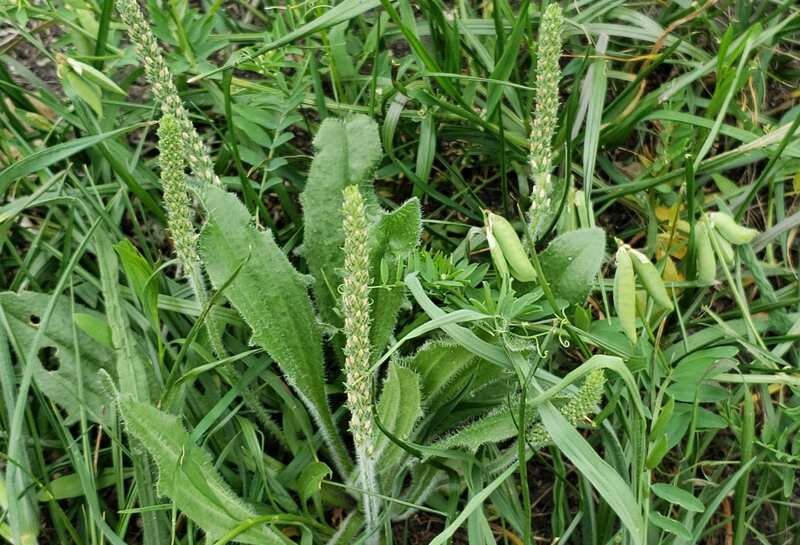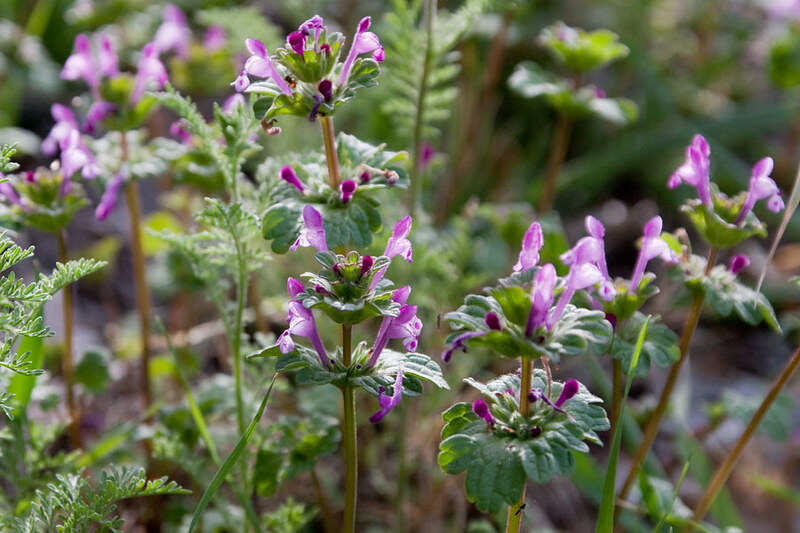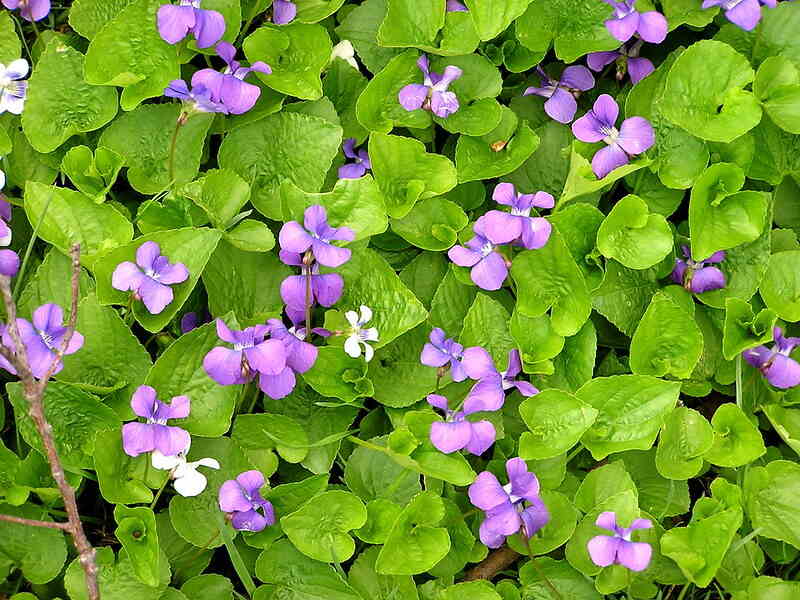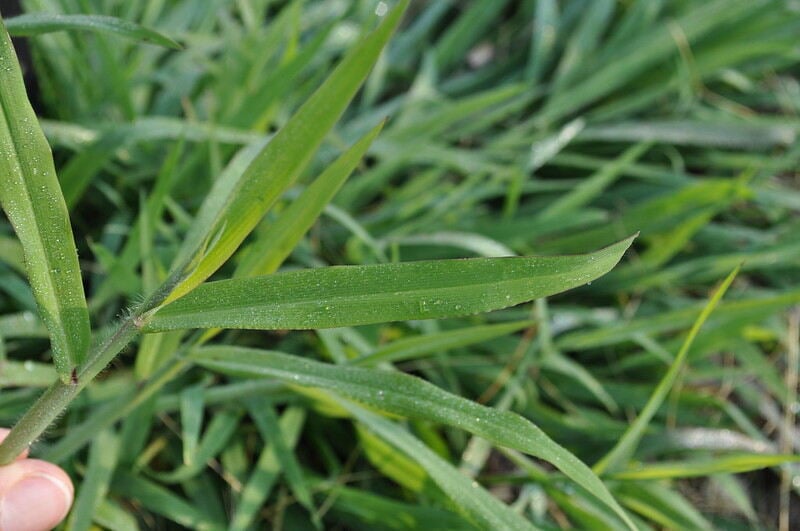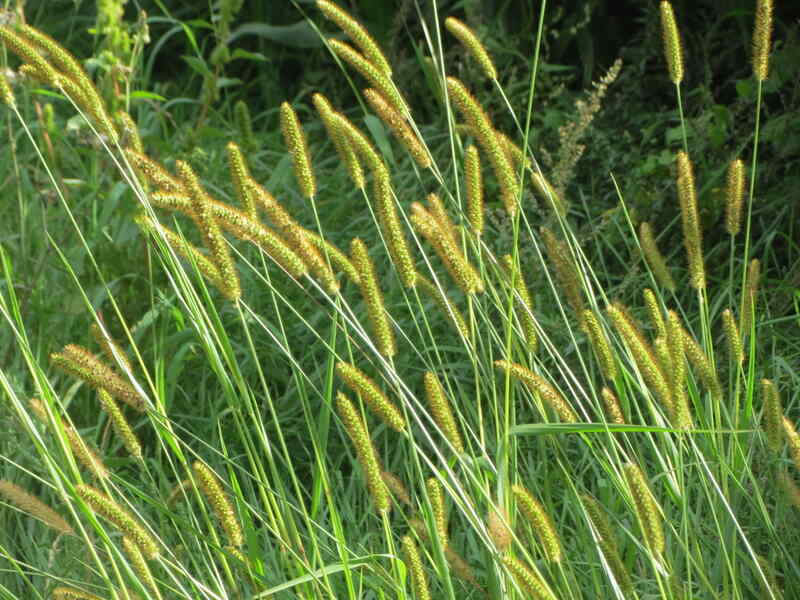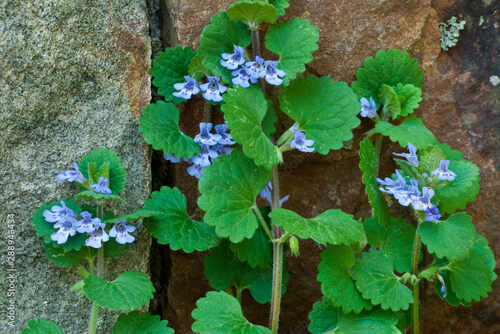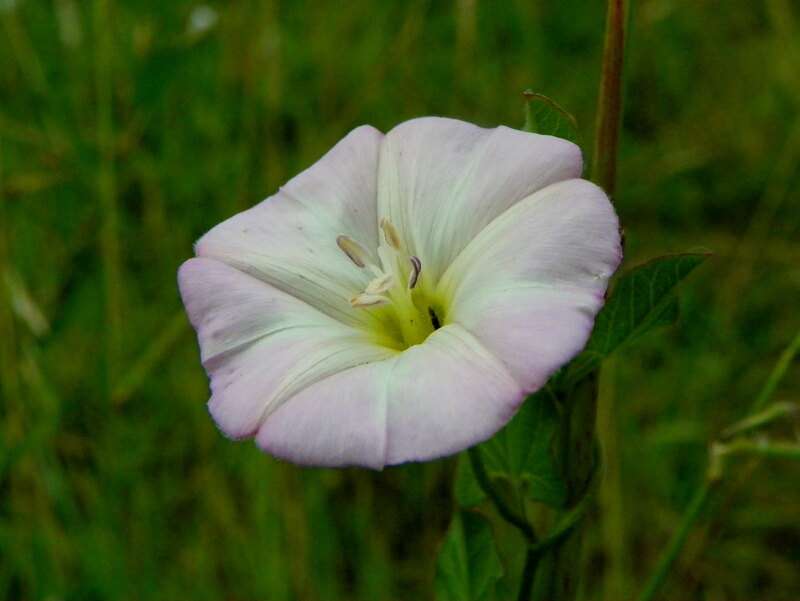
Got weeds growing in your lawn right now? You need a post-emergent herbicide — a weed killer that targets weeds that are already visible and actively growing.
But walk into any store and you’ll face dozens of options: sprays, granules, selective, non-selective, contact, systemic… Which one actually works for your weeds?
This guide breaks down the types of post-emergent herbicides in simple terms so you can choose the right weed killer for your lawn.
Don’t want to figure this out? LawnStarter’s lawn treatment pros know exactly which herbicide kills your specific weeds without harming your grass. We also hand-pull weeds for chemical-free control. Get a free weed control quote and let us handle your weed problem.
| Key takeaways |
|---|
| • For weeds in your lawn: Use selective herbicides • For non-lawn areas: Use non-selective herbicides • For a complete kill: Choose systemic herbicides • For fast results: Choose contact herbicides • Application method: Liquid or granular • Best time: Spring and fall |
What is Post-Emergent Herbicide?

Post-emergent herbicide kills weeds that are already growing in your lawn. These weeds have already sprouted above the soil and are actively growing.
Post-emergent vs. pre-emergent herbicide:
- Post-emergent: Use for killing existing weeds you can see growing above the ground.
- Pre-emergent: Apply pre-emergent herbicides before weeds appear to prevent weed seeds from sprouting.
When to use post-emergent: Spring and fall, when weeds are young and actively growing. Note that young weeds are easier to kill than mature, established weeds.
See Related:
Quick Guide: How to Choose the Right Post-Emergent
With numerous types, brands, and variations of herbicides available, determining which weed killer to use can be a time-consuming process.
Here’s a quick guide to help you figure out which post-emergent herbicide to use, depending on your situation:
| Your Situation | Type You Need | Examples |
| Kill weeds in the lawn without harming the grass | Selective | Most lawn weed killers (Ortho Weed B-Gon, Spectracide) |
| Kill everything (driveway, patio, fence line) | Non-selective | Roundup Weed & Grass Killer, Spectracide Weed & Grass Killer Concentrate |
| Kill dandelions, clover, chickweed | Selective broadleaf weed killer | 2,4-D products, Gordon’s SpeedZone Lawn Weed Killer |
| Kill crabgrass in the lawn | Selective crabgrass killer | Quinclorac products, Drive XLR8 |
| Fast, visible results (within hours) | Contact | Liquid formulas with pelargonic acid |
| Complete kill, including roots (willing to wait 7 to 14 days) | Systemic | Most products with 2,4-D, dicamba |
Pro Tip: St. Augustinegrass and centipedegrass are sensitive to many herbicides. So, always check the product label to ensure it’s safe for your grass.
Main Types of Post-Emergent Herbicides
With 6 major types of post-emergent herbicides available, you have several options for weed control in your yard. To help you choose the best herbicide for your needs, I will provide more information about each one and its specific uses.
Systemic vs. Contact Post-Emergent Herbicides
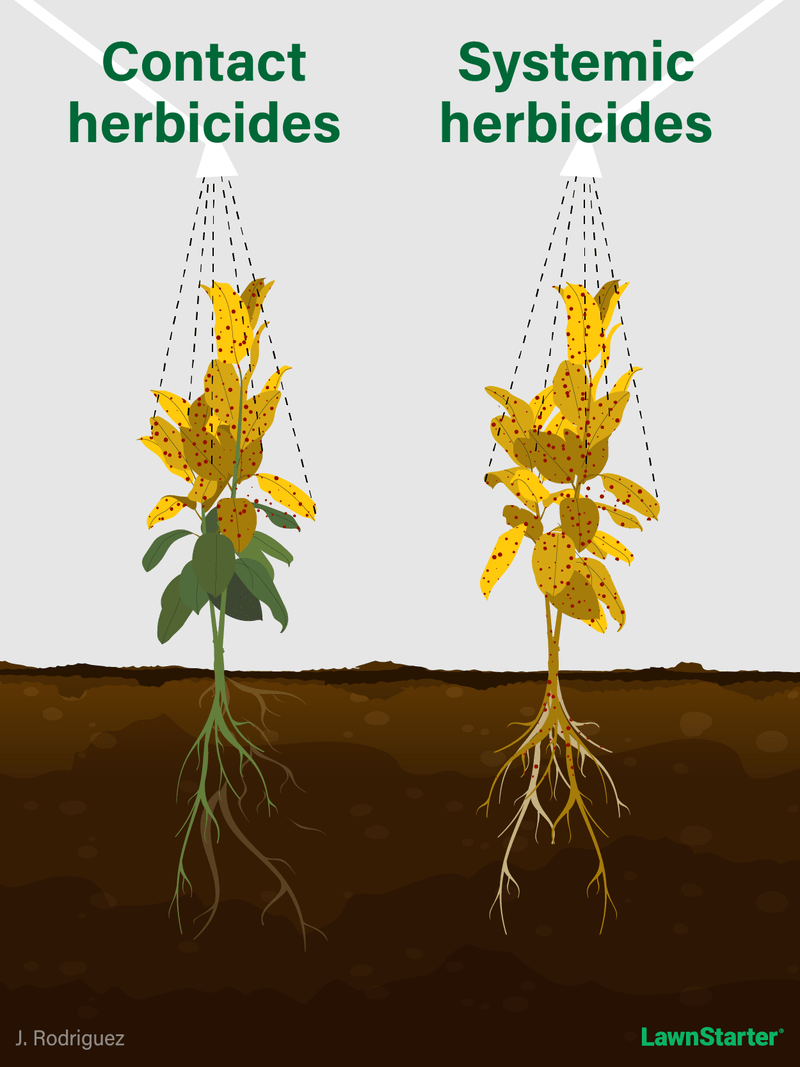
The main difference between them is how deeply they kill weeds.
| Key Factors | Systemic (most common) | Contact (less common) |
| How it works | Travels to the roots, killing the above-ground foliage and the root system | Kills only the parts of the plant it touches; the weed dies quickly, but roots may survive |
| How fast it works | Takes 3-14 days to see results | Works rapidly, with visible damage within hours to 2 days |
| Weeds it kills | Dandelions, clover, crabgrass, plantain, chickweed, wild violet | Young annual weeds, spurge, foxtail, purslane |
| Examples | Glyphosate | Scythe (pelargonic acid) |
Note: While pelargonic acid is an organic compound, not all products made with it are organic (certified by the Organic Materials Review Institute) as well. So, if you want an organic post-emergent herbicide, check out our article: Organic Herbicides: A Comprehensive Guide.
Pro Tip: Most homeowners use systemic herbicides because they kill weeds completely. Contact herbicides work faster but often require multiple applications.
Selective vs. Non-Selective Post-Emergent Herbicides
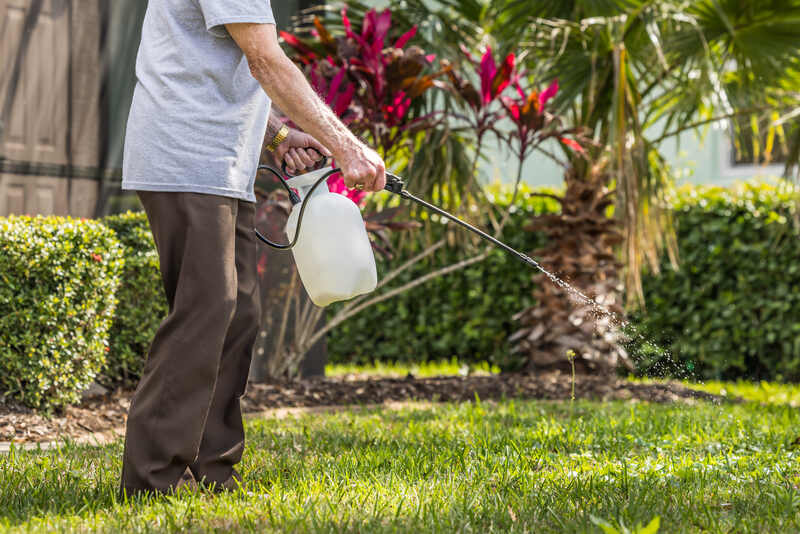
Choosing between a selective and non-selective post-emergent will depend on whether you’re killing weeds in your lawn or clearing large weed-infested areas.
| Key Factors | Selective | Non-Selective |
| How it works | Kills specific weed species without harming other, non-target plants | Kills all plants it comes into contact with |
| Effectiveness | Requires multiple applications for best results | Can kill weeds in as little as one application |
| Cost | More expensive than non-selective | More cost-effective, especially for large-scale weed removal |
| Best for | Targeted weed control in lawns | Clearing large areas or removing weeds in driveways and patios |
| Examples | Ortho Weed B-Gon, Drive XLR8 | Compare-N-Save Concentrate |
Pro Tip: Not all grass types can tolerate selective herbicides. So, check the label to ensure it’s safe for your type of grass.
Granular vs. Liquid Post-Emergent Herbicides
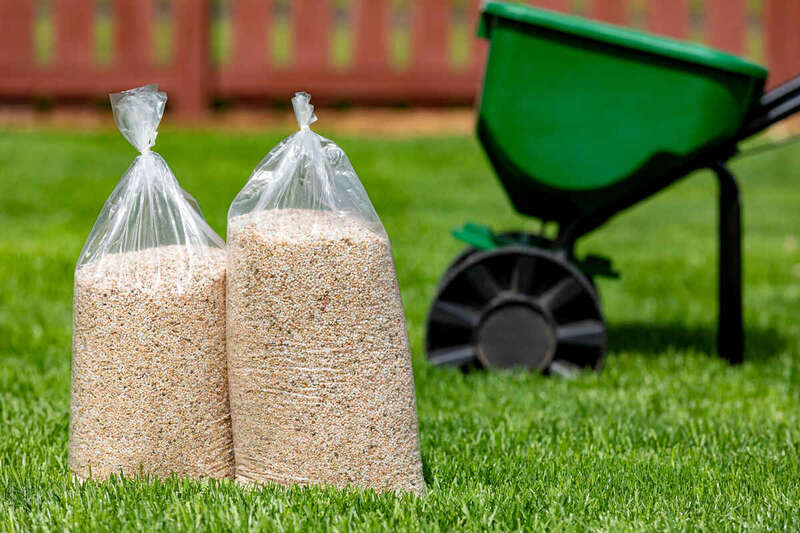
While granular post-emergents typically have a longer shelf life, liquid post-emergents are more popular among homeowners and pros.
| Key Factors | Granular | Liquid |
| Application method | Applied using a lawn spreader | Applied using a sprayer |
| How fast it works | Slower than liquid, as it requires moisture to activate | Absorbed quickly, showing faster results |
| Precision | Harder to control distribution, leading to uneven application | Targeted spot treatment minimizes impact on surrounding plants |
| Best for | Large lawns with widespread weed problems; weed and feed | Spot treatments (targeted coverage) |
| Examples | Scotts Turf Builder Weed & Feed | Roundup Ready-to-Use, Spectracide Weed Stop |
Pro Tip: Most pros prefer liquid post-emergents because they work faster and allow precise targeting of specific weeds.
See Related: How to Choose The Right Lawn Spreader
Which Weeds Are You Fighting?
Match your weed to the right herbicide:
Broadleaf weeds (use a selective broadleaf killer):
- Dandelions
- Clover (white, red)
- Plantain
- Chickweed
- Henbit
- Wild violet
- Spurge
Grassy weeds (use selective grass killer):
- Crabgrass
- Foxtail
- Goosegrass
- Annual bluegrass (Poa annua)
Tough perennials (use systemic herbicide, may need multiple applications):
- Dandelions with deep taproots
- Wild violet
- Ground ivy (creeping Charlie)
- Bindweed
Common Active Ingredients (What’s Inside Post-Emergents)
You’ll see these chemicals commonly used in post-emergent weed killers:
- 2,4-D: Kills dandelions, clover, plantain (most common)
- Dicamba: Kills tough broadleaf weeds
- MCPP (mecoprop): Kills chickweed, clover
- Triclopyr: Kills difficult weeds like wild violet
- Quinclorac: Kills crabgrass without harming most lawn grasses
- Glyphosate: Non-selective, kills all plants
- Glufosinate: Non-selective, faster than glyphosate
- Pelargonic acid: Fast-acting contact killer, burns weeds
- Acetic acid (vinegar): Contact killer for annual weeds
Read Next: Applying Post-Emergent Herbicides to Your Lawn
FAQ About Post-Emergent Herbicides
No, the chemicals may be too strong for the young grass. Wait until after the third or fourth mow, or as long as an entire growing season, before applying any weed killer.
It depends on the herbicide. For example, contact post-emergents can take as little as a few hours to show results, while systemic post-emergents can take a few days to 2 weeks before you see results.
Yes, vinegar can kill weeds. Vinegar with 5% acetic acid can kill young weeds, while 20% acetic acid can kill even established plants.
No, post-emergent herbicides are not safe for pets if used improperly. Keep your pets away from treated areas for a day or two or until fully dry. As always, follow the instructions on the label to keep your pets safe. If in doubt, extend the time you keep pets off the lawn after application or use pet-safe organic herbicides.
Let LawnStarter Handle Your Weeds
Choosing the right post-emergent herbicide means identifying your weeds, knowing your grass type, understanding product labels, timing application correctly, and applying safely. Miss any of these, and you might kill your grass or waste money on products that don’t work.
LawnStarter’s lawn treatment pros:
- Identify your specific weeds
- Use professional-grade herbicides
- Hand-pull weeds for chemical-free control
- Guarantee results
Skip the guesswork and let the pros handle your weed problem.
Get a free quote for weed control →
Sources:
- “Translocation of Foliar-Applied Herbicides.” Plant & Soil Sciences eLibrary, University of Nebraska-Lincoln.
- “Weed Control in Home Lawns.” University of Georgia Extension.
- “Weed Management in Landscapes.” University of California Integrated Pest Management.
- “You Only Need Four Post-Emergent Herbicides.” By Daniel Leonard, county Extension director. University of Florida IFAS Extension.
Main Image: Post emergent herbicide being sprayed on green lawn. Image Credit: New Africa / Adobe Stock


